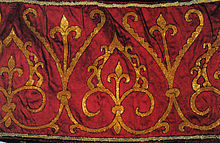Dalmatica (imperial regalia)
The Dalmatica (or dalmatic ), also blue tunicle called the crown jewels was originally liturgical garb and was mid-12th century in Sicily manufactured and later belonged to the coronation of the Holy Roman Emperor .
Today it is in the secular treasury in Vienna.
Appearance
The Dalmatica consists of a deep dark blue silk fabric called Samit . The blue color is an indigo madder color. The occasional claim that the color is purple is not correct. The eight-inch-wide trimmings on the sleeves and on the lower hem are made of the same red silk fabric as the fabric of the coronation coat . The hem border is bordered by two rows of embroidered pearls on the upper and lower edges. A gold braid was used to border the neckline, which in turn is enclosed by a row of pearls.
The hem border is embroidered with palmette shapes , palm-shaped ornaments, with narrow lilies. Gold threads were used as embroidery material. For the embroidery on the sleeve borders, however, thin gold tubes were used through which the threads were pulled.
The same material used and the similarity of the style of the embroidery to that of the coronation mantle suggest that both pieces were created at the same time and therefore for the Norman king in Sicily Roger II in his workshop, the Nobiles Officinae . Perhaps both pieces originally belonged to the same regalia, as they later served together as the coronation regalia of the imperial regalia.
history
Origin and first mentions
The Dalmatica can be reliably proven for the first time in the certificate of handover of the imperial regalia to King Charles IV from 1350. There it is mentioned as:
- eyn blawer rok, geworcht on the arms with gold beads with VND ( ref : cited in Seipel et al.)
But a Rochk von Samitte is already mentioned in the Trifels inventory of 1246 . Since the other pieces of regalia, i.e. coat, shoes, stockings and gloves are also present, one can assume that the dalmatica is also described here.
The first known representation of the Dalmatica is the above engraving by Johann Adam Delsenbach on which the Dalmatica under it carried white Alba is visible. The pattern of the lower hem band and the sleeve cuffs are clearly visible.
Safekeeping in Nuremberg
The further history of the Dalmatica is inextricably linked with that of the other imperial regalia (see there).
With these, the dalmatica was kept in various places in the empire during the High and Late Middle Ages: first on the Trifels , later a. a. in the Karlštejn Castle near Prague, at that time the main residence of the Luxembourg dynasty, or in the Hersfeld Imperial Abbey .
In 1423 King Sigismund gave the imperial city of Nuremberg the privilege and task of keeping imperial regalia for ever, irrevocably and incontestably . This became necessary because, due to the Hussite Wars, the former storage location in Prague was no longer safe. The imperial regalia were kept in a chest hung in the choir of the Nuremberg Holy Spirit Church until shortly before the end of the empire. Once a year they were shown to the public at the so-called healing instruction .
On April 3, 1764, Joseph II was crowned Roman-German King in Frankfurt while still alive and in the presence of his father, Emperor Franz I. On this occasion, a replica of the coronation regalia - and thus also the dalmatica - was made for Franz I, so that the father did not have to stand behind his son and the son could still be crowned in the original robes according to tradition.
literature
- Hermann Fillitz : The insignia and jewels of the Holy Roman Empire. Schroll, Vienna a. a. 1954.
- Wilfried Seipel (Ed.): Nobiles Officinae. The royal court workshops at Palermo during the Normans and Staufers in the 12th and 13th centuries. Skira, Milano 2004, ISBN 3-85497-076-5 .

